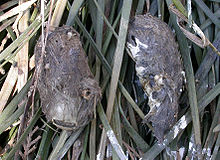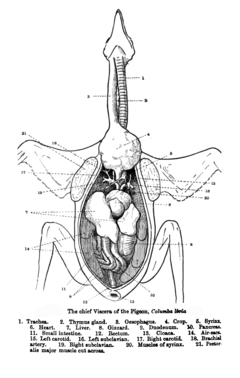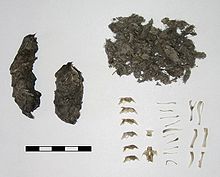
Pellet (ornithology)
Encyclopedia




Ornithology
Ornithology is a branch of zoology that concerns the study of birds. Several aspects of ornithology differ from related disciplines, due partly to the high visibility and the aesthetic appeal of birds...
, is the mass of undigested parts of a bird's
Bird
Birds are feathered, winged, bipedal, endothermic , egg-laying, vertebrate animals. Around 10,000 living species and 188 families makes them the most speciose class of tetrapod vertebrates. They inhabit ecosystems across the globe, from the Arctic to the Antarctic. Extant birds range in size from...
food that some bird species occasionally regurgitate
Regurgitation (digestion)
Regurgitation is the expulsion of material from the mouth, pharynx, or esophagus, usually characterized by the presence of undigested food or blood.Regurgitation is used by a number of species to feed their young...
. The contents of a bird's pellet depend on its diet, but can include the exoskeleton
Exoskeleton
An exoskeleton is the external skeleton that supports and protects an animal's body, in contrast to the internal skeleton of, for example, a human. In popular usage, some of the larger kinds of exoskeletons are known as "shells". Examples of exoskeleton animals include insects such as grasshoppers...
s of insects, indigestible plant matter, bones, fur, feathers, bills, claws, and teeth. In falconry
Falconry
Falconry is "the taking of wild quarry in its natural state and habitat by means of a trained raptor". There are two traditional terms used to describe a person involved in falconry: a falconer flies a falcon; an austringer flies a hawk or an eagle...
, the pellet is called a casting.
The passing of pellets allows a bird to remove indigestible material from its proventriculus
Proventriculus
The proventriculus is part of the digestive system of birds, invertebrates and insects.-Birds:The proventriculus is a standard part of avian anatomy...
, or glandular stomach
Stomach
The stomach is a muscular, hollow, dilated part of the alimentary canal which functions as an important organ of the digestive tract in some animals, including vertebrates, echinoderms, insects , and molluscs. It is involved in the second phase of digestion, following mastication .The stomach is...
. In birds of prey, the regurgitation of pellets serves the bird's health in another way, by "scouring" parts of the digestive tract, including the gullet. Pellets are formed within six to ten hours of a meal in the bird's gizzard
Gizzard
The gizzard, also referred to as the ventriculus, gastric mill, and gigerium, is an organ found in the digestive tract of some animals, including birds, reptiles, earthworms and some fish. This specialized stomach constructed of thick, muscular walls is used for grinding up food; often rocks are...
(muscular stomach).
Ornithologists may collect one species' pellets over time to analyze the seasonal variation in its eating habits. One advantage of collecting pellets is that it allows for the determination of diet without the killing and dissection of the bird. Pellets are found in different locations, depending on the species. In general, roosting and nesting
Bird nest
A bird nest is the spot in which a bird lays and incubates its eggs and raises its young. Although the term popularly refers to a specific structure made by the bird itself—such as the grassy cup nest of the American Robin or Eurasian Blackbird, or the elaborately woven hanging nest of the...
sites are good places to look: for most hawks and owls, under coniferous trees; for Barn Owl
Barn Owl
The Barn Owl is the most widely distributed species of owl, and one of the most widespread of all birds. It is also referred to as Common Barn Owl, to distinguish it from other species in the barn-owl family Tytonidae. These form one of two main lineages of living owls, the other being the typical...
s, at the bases of cliffs or in barns and silos; for yet other species of owls, at their burrow
Burrow
A burrow is a hole or tunnel dug into the ground by an animal to create a space suitable for habitation, temporary refuge, or as a byproduct of locomotion. Burrows provide a form of shelter against predation and exposure to the elements, so the burrowing way of life is quite popular among the...
s or in marsh and field grasses (Terres, 1980).
Hawk
Hawk
The term hawk can be used in several ways:* In strict usage in Australia and Africa, to mean any of the species in the subfamily Accipitrinae, which comprises the genera Accipiter, Micronisus, Melierax, Urotriorchis and Megatriorchis. The large and widespread Accipiter genus includes goshawks,...
and owl
Owl
Owls are a group of birds that belong to the order Strigiformes, constituting 200 bird of prey species. Most are solitary and nocturnal, with some exceptions . Owls hunt mostly small mammals, insects, and other birds, although a few species specialize in hunting fish...
pellets are grey or brown, and range in shape from spherical to oblong or plug-shaped. In large birds, they are one to two inches long, and in songbird
Songbird
A songbird is a bird belonging to the suborder Passeri of the perching birds . Another name that is sometimes seen as scientific or vernacular name is Oscines, from Latin oscen, "a songbird"...
s, about half an inch. Many other species produce pellets, including grebe
Grebe
A grebe is a member of the Podicipediformes order, a widely distributed order of freshwater diving birds, some of which visit the sea when migrating and in winter...
s, heron
Heron
The herons are long-legged freshwater and coastal birds in the family Ardeidae. There are 64 recognised species in this family. Some are called "egrets" or "bitterns" instead of "heron"....
s, cormorant
Cormorant
The bird family Phalacrocoracidae is represented by some 40 species of cormorants and shags. Several different classifications of the family have been proposed recently, and the number of genera is disputed.- Names :...
s, gull
Gull
Gulls are birds in the family Laridae. They are most closely related to the terns and only distantly related to auks, skimmers, and more distantly to the waders...
s, tern
Tern
Terns are seabirds in the family Sternidae, previously considered a subfamily of the gull family Laridae . They form a lineage with the gulls and skimmers which in turn is related to skuas and auks...
s, kingfisher
Kingfisher
Kingfishers are a group of small to medium sized brightly coloured birds in the order Coraciiformes. They have a cosmopolitan distribution, with most species being found in the Old World and Australia...
s, crow
Crow
Crows form the genus Corvus in the family Corvidae. Ranging in size from the relatively small pigeon-size jackdaws to the Common Raven of the Holarctic region and Thick-billed Raven of the highlands of Ethiopia, the 40 or so members of this genus occur on all temperate continents and several...
s, jay
Jay
The jays are several species of medium-sized, usually colorful and noisy, passerine birds in the crow family Corvidae. The names jay and magpie are somewhat interchangeable, and the evolutionary relationships are rather complex...
s, dipper
Dipper
Dippers are members of the genus Cinclus in the bird family Cinclidae, named for their bobbing or dipping movements. They are unique among passerines for their ability to dive and swim underwater.-Description:...
s, shrike
Shrike
Shrikes are passerine birds of the family Laniidae. The family is composed of thirty-one species in three genera. The family name, and that of the largest genus, Lanius, is derived from the Latin word for "butcher", and some shrikes were also known as "butcher birds" because of their feeding habits...
s, swallows, and most shorebirds.
Ornithologists examining pellets have discovered unusual items in them—even bird bands that were once attached to a smaller species that was consumed by the predator bird. In the United States, screech owl
Scops owl
Scops owls are Strigidae belong to the genus Otus. Approximately 45 living species are known, but new ones are frequently recognized and unknown ones are still being discovered every few years or so, especially in Indonesia...
pellets have contained bands from a Tufted Titmouse
Tufted Titmouse
The Tufted Titmouse, Baeolophus bicolor, is a small songbird from North America, a species in the tit and chickadee family . The Black-crested Titmouse, found from central and southern Texas southwards, was included as a subspecies but is now considered a separate species B...
, Black-capped Chickadee
Black-capped Chickadee
The Black-capped Chickadee is a small, North American songbird, a passerine bird in the tit family Paridae. It is the state bird of both Maine and Massachusetts in the United States, and the provincial bird of New Brunswick in Canada...
, and American Goldfinch
American Goldfinch
The American Goldfinch , also known as the Eastern Goldfinch and Wild Canary, is a small North American bird in the finch family...
. In 1966, a Golden Eagle
Golden Eagle
The Golden Eagle is one of the best known birds of prey in the Northern Hemisphere. Like all eagles, it belongs to the family Accipitridae. Once widespread across the Holarctic, it has disappeared from many of the more heavily populated areas...
pellet in Oregon
Oregon
Oregon is a state in the Pacific Northwest region of the United States. It is located on the Pacific coast, with Washington to the north, California to the south, Nevada on the southeast and Idaho to the east. The Columbia and Snake rivers delineate much of Oregon's northern and eastern...
was found to contain a band placed on an American Wigeon
American Wigeon
The American Wigeon, also American Widgeon or Baldpate, is a species of wigeon in the dabbling duck genus Anas. If this is split up, all wigeons will go into their old genus Mareca again...
four months earlier, and 1600 km (994.2 mi) away in southern California
California
California is a state located on the West Coast of the United States. It is by far the most populous U.S. state, and the third-largest by land area...
(Terres, 1980).
The hair, bones and other body parts (such as limbs, skin fragments, and even faeces) of rodents found in owl pellets may carry viable rodent viruses and bacteria
Bacteria
Bacteria are a large domain of prokaryotic microorganisms. Typically a few micrometres in length, bacteria have a wide range of shapes, ranging from spheres to rods and spirals...
. It is therefore advisable to sterilize pellets in a microwave oven
Microwave oven
A microwave oven is a kitchen appliance that heats food by dielectric heating, using microwave radiation to heat polarized molecules within the food...
before study. This is particularly important when using pellets at school. Recently, Smith et al. (2005) described two pellet-borne outbreaks of Salmonella typhimurium in public schools. Not surprisingly, rodents tend to avoid owl pellets, apparently due to their infective potential (Sike & Rozsa 2006).
In Falconry
In falconryFalconry
Falconry is "the taking of wild quarry in its natural state and habitat by means of a trained raptor". There are two traditional terms used to describe a person involved in falconry: a falconer flies a falcon; an austringer flies a hawk or an eagle...
, casting involves giving a hawk
Hawk
The term hawk can be used in several ways:* In strict usage in Australia and Africa, to mean any of the species in the subfamily Accipitrinae, which comprises the genera Accipiter, Micronisus, Melierax, Urotriorchis and Megatriorchis. The large and widespread Accipiter genus includes goshawks,...
roughage, which is regurgitated
Regurgitation (digestion)
Regurgitation is the expulsion of material from the mouth, pharynx, or esophagus, usually characterized by the presence of undigested food or blood.Regurgitation is used by a number of species to feed their young...
later to purge and cleanse its crop
Crop (anatomy)
A crop is a thin-walled expanded portion of the alimentary tract used for the storage of food prior to digestion that is found in many animals, including gastropods, earthworms, leeches, insects, birds, and even some dinosaurs.- Bees :Cropping is used by bees to temporarily store nectar of flowers...
. Hawks in the wild will produce castings of their own accord, in the form of small pellets
Pellet (ornithology)
A pellet, in ornithology, is the mass of undigested parts of a bird's food that some bird species occasionally regurgitate. The contents of a bird's pellet depend on its diet, but can include the exoskeletons of insects, indigestible plant matter, bones, fur, feathers, bills, claws, and teeth...
of fur, feathers, and other undigestible material, regurgitated hours after it has eaten. Of the roughage used for falcons in captivity, there are two kinds: plumage, and cotton; the latter of which is generally in pellets about the size of hazelnut
Hazelnut
A hazelnut is the nut of the hazel and is also known as a cob nut or filbert nut according to species. A cob is roughly spherical to oval, about 15–25 mm long and 10–15 mm in diameter, with an outer fibrous husk surrounding a smooth shell. A filbert is more elongated, being about twice...
s, made of soft fine cotton, and conveyed into the hawk's gorge after supper. In the morning, the hawk will have cast them out, at which time they should be examined for color and condition to determine the state of the hawk's body. If they are cast out round, white, without stench, nor very moist, then the hawk is healthy; if otherwise, particularly black, green, slimy, or the like, the hawk is ill.
The casting of plumage is examined in the same manner. The yellow down feathers
Down feathers
The down of birds is a layer of fine feathers found under the tougher exterior feathers. Very young birds are clad only in down. Powder down is a specialized type of down found only in a few groups of birds. Down is a fine thermal insulator and padding, used in goods such as jackets, bedding,...
of day-old cockerel chicks, which are a common diet among hawks in captivity, can be enough to induce casting. However, rabbit fur and feathers from game birds are better suited for this purpose.
Casting will occur at the same time daily, provided that hawks are flown at the same time daily. Hawks in captivity are usually weighed immediately before being flown. If they were fed roughage the previous day, they should cast it out before being weighed, to avoid an inaccurate measurement.
Casting is a necessary part of a hawk's survival. Not only does it clear out the crop, but the roughage that is regurgitated cleans bacteria from the walls of the crop. If hawks in captivity are not provided with this necessary roughage, and instead are simply fed meat, they will become seriously ill and unreleasable into the wild.

